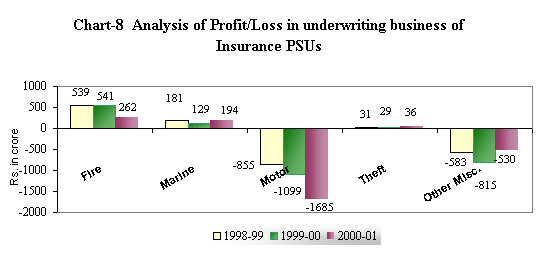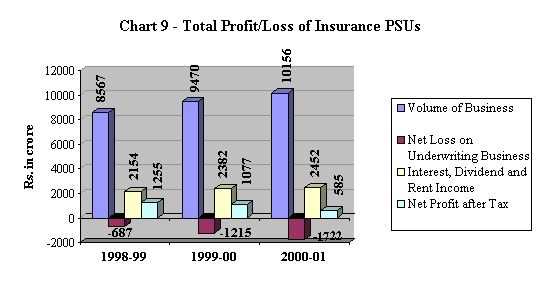CHAPTER 5
GENERAL INSURANCE
5.1 General Insurance Companies
The General Insurance Corporation of India Limited, a Government Company, is registered under the Insurance Act, 1938 as well as the Companies Act, 1956 and is the holding Company in respect of four subsidiary companies. The holding Company conducts business in respect of all kinds of insurance policies except motor vehicle and theft insurance, which are conducted only by the subsidiaries which also conduct business in all areas of insurance. The subsidiary companies of the General Insurance Corporation of India Limited are:
- National Insurance Company Limited, Calcutta.
- The New India Assurance Company Limited, Mumbai.
- The Oriental Insurance Company Limited, New Delhi.
- United India Insurance Company Limited, Chennai.
As on 31 March 2001, the aggregate equity capital of these five Companies was Rs.615 crore and their net worth was Rs.8889.25 crore. The volume of business of these Companies increased from Rs.9469.57 crore in 1999-00 to Rs.10156.16 crore in 2000-01, registering 7.25 percent growth over the period.
5.2 Financial Performance
(i) The overall financial performance as well as segment wise performance of 5 Insurance Companies during the years 1998-99 to 2000-01 are given in Appendix - XI (See also Chart 8 and 9).


(ii) Under the various segments of insurance business, Fire, Marine and Theft Insurance business had generated profits (Rs. 492.82 crore). These profits are, however, more than offset by heavy losses (Rs. 2,215.06 crore ) incurred under motor vehicle insurance and other miscellaneous insurance operations, resulting in overall losses in insurance related business for all the Insurance companies. During the last two years, all the Companies incurred losses in insurance related business. All the 5 companies, however, earned substantial income from their non-insurance operations by way of interest, divided and rent. This helped them show aggregate net profit after tax of Rs. 584.93 crore as indicated in Appendix - XII.
(iii) The loss incurred by the General Insurance companies in underwriting business was mainly due to the loss in third party claims relating to motor insurance business and the loss arising out of other miscellaneous insurance business as reported in the preceding two years as well. The aggregate loss of Rs. 2215 crore in motor insurance and other miscellaneous insurance segments was attributable to the collection of premium substantially lower than the claims paid out. For example, in 2000-01, net premium collected under motor insurance was Rs.3,362.39 crore and the commission received on reinsurance ceded was Rs.191.35 crore making a total income from motor vehicle insurance as Rs.3,553.74 crore. As against this income, the total expenditure including net claims paid and other expenses was Rs.5,239.24 crore bringing the total loss from motor vehicle insurance to Rs.1,685.49 crore during the year (refer Appendix - XII). The total premia collected was 68 per cent of the total expenditure.
(iv) The capital adequacy norms have not been fixed for the insurance companies. However, as per Section 64 VA of the Insurance Act, 1938, solvency margin equivalent to one fifth of the first five crore of rupees and one tenth of the remaining amount of premium income from insurance business during the preceding twelve months is required to be maintained by the insurance companies, failing which the insurer shall be deemed to be insolvent and the insurer may be wound up by the court. Though the above referred solvency margin is maintained by the five insurance companies, in view of ever increasing exposure of general insurance companies to risks, there is a strong need to prescribe capital adequacy norms based on the total risk underwritten by the insurance companies, instead of maintaining solvency margin based on income from general insurance business.
5.3 Reinsurance Operations
(i) The General Insurance Corporation (GIC) of India and its subsidiary companies insure the risks accepted in excess of their retention capacity. This reinsurance is made in accordance with the common annual reinsurance programmes drawn up by GIC every year with the approval of the Ministry. The main objective of the reinsurance programme is to retain maximum premium in India consistent with prudent risk retentions and to secure the best possible protection for cost incurred on reinsurance.
The gross direct premium underwritten by GIC and its subsidiaries and the total net premium retention, after reinsurance, within India during the last three years were as tabulated below:
(Rs. in crore)
|
1998-1999 |
1999-2000 |
2000-01 |
|
|
Gross Direct Premium |
9157.56 |
9982.35 |
10771.83 |
|
Net Premium retained in India |
8402.48 |
9363.51 |
9976.92 |
|
Net Premium ceded to Foreign reinsurers |
755.08 |
618.84 |
794.91 |
|
Average retention margin (per cent) |
91.75 |
93.80 |
92.62 |
5.4 Foreign Operations
(i) As on 31 March 2001, GIC and its subsidiaries had invested Rs.75.79 crore in the total paid up capital of Rs.77.91 crore of three wholly owned subsidiaries (Indian International Insurance Pte. Ltd, Singapore, The New India Assurance Company (Sierra Leone) Limited and The New India Assurance Company (Trinidad & Tobage) Limited) carrying out insurance business in 3 countries. In addition, GIC and its subsidiaries operate 45 offices abroad spread over 17 countries.
(ii) Loss in Overseas operations which was Rs.61.82 crore in 1998-99 decreased during 1999-00 to 45.25 crore but increased sharply in 2000-01 to Rs.118.85 crore. After taking into account income from other sources, net loss which was Rs.37.04 crore during 1998-99 reduced to Rs.24.00 crore during 1999-00 but increased again to Rs.91.90 crore during 2000-01.
5.5 Investments
(i) The income derived by GIC and its subsidiary companies through investment was Rs.2,279.75 crore, Rs.2,491.76 crore and Rs.2,695.69 crore during the years 1998-99, 1999-00 and 2000-01 respectively, which contrasted with overall losses of Rs.686.61 crore, Rs.1,214.55 crore and Rs.1,722.24 crore incurred during these years from their insurance related business. The return realised on investment was 13.10 percent in 1998-99, 12.10 percent 1999-00 and 11.76 per cent in 2000-01.
(ii) The investible funds generated by GIC and its subsidiary companies were Rs.2,322.00 crore in 1998-99, Rs.2,843.00 crore in 1999-2000 and Rs.1,843.40 crore in 2000-01. The fall in investible funds in 2000-01 was mainly on account of reduction in fire premium, increased claim payments, continued recession in the economy, fall in interest rates and higher incidence of non-performing assets.
(iii) GIC received dividend amounting to Rs.65 crore (ranging from 20 percent to 25 percent) from three insurance subsidiaries who declared dividend. However, they in turn paid only Rs.43 crore to Government of India by way of dividend @ 20 per cent as against Rs.64.50 crore paid last year.